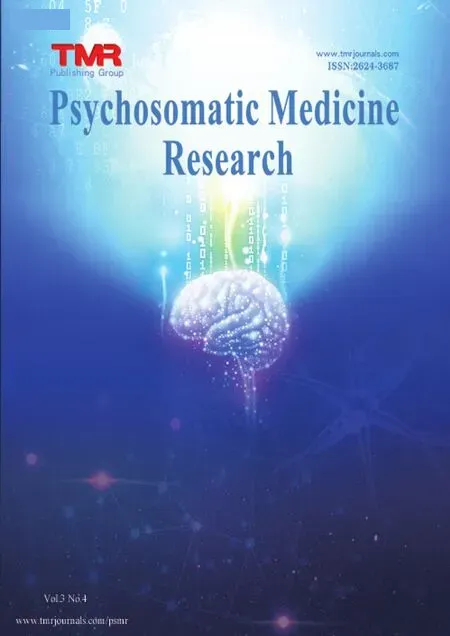A Commentary of the Queer People of Color Identity Affirmation Scale for Positive Attitudes
Yuan Luo,Cong-Zhou Chen,Li-Ping Zhao,3*
1XiangYa Nursing School,Central South University,Changsha,Hunan,China.
2School of Public Health,Imperial College London,London,Britain.
3XiangYa Second Hospital,Central South University,Changsha,Hunan,China.
Keywords:Identity affirmation scale,Queer people of color,Sexual minority
Sexual minority(SM)is gradually becoming more visible as a more open and diversity society.SM mainly includes lesbian,gay,bisexual,transgender,asexual and so on.According to SM stress theory,SM people,populations at risk,have poor mental and physical health under a long-term acute or chronic stress and pressure due to prejudice and discrimination[1].In America,among young SM,minority stress,negative psychology,substance use,and human immunodeficiency virus(HIV)risk influence each other to damage psychosomatic health[2].With an increase in SM stress, participation in health-promoting activities decreased and problems with physical health increased[3].European racists define people of color as all other races except whites,such as blacks,yellows,Latinos,Indians,mixed races and so on.As a result of the prevalence of white supremacy in Western countries,people of color have long suffered from unfair treatment and suffering.Intersectionality first emerged in the black feminism and civil rights movement to explore the influence of dual identities of blacks and women for mental and health problem.Recent years,Intersectionality has been widely applied to gender and race-related health research,not only woman[4].Since 1988,relevant reports have appeared in the United States.Especially in the past decade,with the rise of the SM rights movement,research on sexual minority of people of color(SM-POC)has been paid attention[5].Recently,a study shown that African American sexual minority had significantly higher risks of HIV,sexually transmitted infections,and substance use due to poor mental health from themselves and society [6].However,positive feelings play an important role in the psychological and sexual health,especially in the early years of their lives[7].
The Queer People of Color Identity Affirmation Scale(QPIAS)was developed by Ghabrial and Andersen[8]from Canada in 2021,used to examine positive aspects of SM-POC identity.First,the initial 33 items was generated based on notes from one-on-one,face-to-face, in-depth semi-structured interviews with a diverse group of 10 SM-POC.Then pilot-tested these items by 293 as an “SM”“ethnic/racial minority person”were to examine expression.Finally,authors administered the scale to 703 SM-POC for exploratory and confirmatory factor analyses.Data were collected with a web-based survey through social media(n=566)and an undergraduate research pool(n=137).A diverse sample was mainly from the Americas,Europe and Asia.The final scale had a two-factor structure and 12 items,all of which loaded above 0.50.EFA showed that 61.00% of variance was explained,with factors 1 and 2 explaining 43.75% and 17.25% of the variance.CFA showed bi-factor model had the best fit,and two subscales significantly positively correlated.Factor 1 was named Identity-Based Growth which expressed beliefs about strength and distinction based upon unique lived experience,and Factor 2 named Identity Cohesion which reflected attitude toward holding both SM and ethnoracial minority identity categories.Internal consistency was very good for the QPIAS(Cronbach's α=0.87),Identity-Based Growth(Cronbach's α=0.87),and Identity Cohesion(Cronbach's α=0.80).There are 7 levels for each item,ranging from 1(very strongly disagree)to 7(very strongly agree).Factor 1 has a total score range of 7 to 49 with 7 items,and Factor 2 has a total score range of 5 to 35 with 5 items including 3 reverse-scored items.The more positive attitude showed up in higher scores.
There is only a limited amount of research on SM,and it focuses on stress and negative effects.To a large extent,the racial experience and positive attitudes of SM have not been explored.Authors developed this scale as the first tool to examine positive aspects of SM-POC identity.Currently,it is only based on two factors,but other factors can be explored in the future.Due to the fact that SM-POC people rarely come out publicly,compared with the white,it is difficult to research people with similar identities.It is worth to explore the association between SM-POC and SM community.As a first step,it can explore the degree of SM-POC identity affirmation,find problem,assess stressors,and apply strengths to promote acceptance and self-acceptance.In spite of the use of a large,diverse and international sample,the interviews with 10 SM-POC aged 18 to 33 did not include opinions from the senior population.In addition,data is collected online.Initial data clean cannot be guaranteed the truth.Finally,the sample included in the pilot study appeared to belong to a privileged socioeconomic status,which may lead to results as desired.Future research can verify this in low-income and low-educated population.
Almost a third of the sample by the scale is from Asia,which makes it possible to apply in Asia(such as China).In China,a large of researches was on gay,AIDS,and social attitudes.Only a few researches are mental and physical health[9].In 2016,according to"Report on the Living Conditions of Chinese Sexual Minorities",Only 5% SM people have disclosed their sexual orientation or gender identity,and most of them are still subject to long-term pressure.Moreover,since Asian culture differs from American culture,the applications need improvement.
 Psychosomatic Medicine Resesrch2021年4期
Psychosomatic Medicine Resesrch2021年4期
- Psychosomatic Medicine Resesrch的其它文章
- Advances in the Pathogenesis of Vascular Cognitive Impairment
- Left Temporal Lobe Arachnoid Cyst Presenting with Symptoms of Psychosis
- Intervention Study on Hypnotherapy of Primary Dysmenorrhea in Female College Students
- An Assessment of the Relationship Between Mizaj and Happiness in College Students During and After Complete Lockdown
- Analysis of the Influence of the Self-efficacy of College Students on Their Response Behaviors Toward COVID-19
